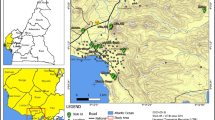Abstract
The stability of both natural and cut slopes in mountainous areas is a great challenge to highway constructions and operations. This paper presents a successful case study of stability analyses and protection treatments for high-steep cut soil slopes in an ancient landslide zone which was located at Km12+700 to Km15+000 along the Tehran–Chalus highway. This report has three parts. First, geotechnical investigations of in situ direct shear test, SPT tests and laboratory tests were implemented to get the subsurface profiles and the mechanical properties of the soil mass. Second, finite difference analysis was carried out to evaluate the stability of both the natural and cut slopes. Minimum safety factors and potential failure modes of cut slopes were obtained under both static and dynamic conditions. These results indicated that the ancient landslide could not be reactivated under the present climatic and morphological conditions, but there were some potential shallow failures in some cut soil slopes (failure actually occurred during excavation). Protection treatments and reinforcements were thus necessary. Third, the stability of the cut slopes was re-assessed by simplified Bishop limit equilibrium analysis (using Slide 5.0). Some potential failure zones were designed to be protected by back-anchored concrete retaining wall at the slope toe, rock bolts and frame beams on the slope face and planting grass on the slope face. Numerical analysis indicated that these protection measures could stabilize this remedial slope. These practical experiences may be of benefit for similar highway construction projects.








Similar content being viewed by others
References
Al-Homoud AS, Tal AB, Taqieddin SA (1997) A comparative study of slope stability methods and mitigative design of a highway embankment landslide with a potential for deep seated sliding. Eng Geol 47(1–2):157–173
Cernica JN (1995) Geotechnical engineering: soil mechanics. John Wiley, NY, pp 287–290
Chau KT, Sze YL, Fung MK, Wong WY, Fong EL, Chan LCP (2004) Landslide hazard analysis for Hong Kong using landslide inventory and GIS. Comput Geosci 30(4):429–443
Dai FC, Lee CF, Ngai YY (2002) Landslide risk assessment and management: an overview. Eng Geol 64(1):65–87
Das BM (1999) Principles of geotechnical engineering, 5th edn. Wadsworth Group, CA, pp 311–357
Enoki M, Kokubu AA, Ikeda Y (1999) Infiltration of rainwater and slope failure. In: Proceeding of the ninth international conference and field trip on landslides, Bristol, 5–16 Sept 1999, pp 27–35
Guzzetti F, Carrara A, Cardinali M, Reichenbach P (1999) Landslide hazard evaluation: a review of current techniques and their application in a multi-scale study, Central Italy. Geomorphology 31(1–4):181–216
Kwong AKL, Wang M, Lee CF, Law KT (2004) A review of landslide problems and mitigation measures in Chongqing and Hong Kong: similarities and differences. Eng Geol 76(1–2):27–39
Lo SCR, Xu DW (1992) A strain based design method for the collapse limit state of reinforced soil walls and slopes. Can Geotech J 29(8):832–842
Nichol D, Graham JR (2001) Remediation and monitoring of a highway across an active landslide at Trevor, North Wales. Eng Geol 59(3–4):337–348
Nouri H, Fakher A, Jones CJFP (2006) Development of horizontal slice method for seismic stability analysis of reinforced slopes and walls. Geotext Geomembr 24(3):175–187
Oztekin B, Kolat C (2006) Assessment of degradation and stability of a cut slope in limestone, Ankara-Turkey. Eng Geol 84(1–2):12–30
Pipkin BW, Trent DD (1997) Geology and the environment, 2nd edn. International Thomson Publishing Company, UK, pp 85–86
Rocscience (2007) Slide, scientific software—2D limit equilibrium slope stability for soil and rock slopes. Version 5.0. Rocscience Inc., Canada
Shahgholi M, Fakher A, Jones CJFP (2001) Horizontal slice method of analysis. Géotechnique 51(10):881–885
Thomas P, Thomas G, Alain D (2010) Stability analysis of a human-influenced landslide in eastern Belgium. Geomorphology 120(1):38–47
Vermeer PA, Ankana Punlor, Ruse N (2001) Arching effects behind a soldier pile wall. Comput Geotech 28(6–7):379–396
Wang JC, Tan WH, Feng SW, Zhou RD (2000) Reliability analysis of an open pit coal mine slope. Int J Rock Mech Min Sci 37(4):715–721
Wei ZA, Li SH, Wang JG, Wan L (2006) A dynamic comprehensive method for landslide control. Eng Geol 84(1–2):1–11
Yilmazer I (1995) Significance of discontinuity survey in motorway alignment selection. Eng Geol 40(1–2):41–48
Yilmazer I, Yilmazer O, Cem S (2003) Case history of controlling a major landslide at Karandu, Turkey. Eng Geol 70(1–2):47–53
Záruba Q, Mencl V (1982) Landslides and their control (Sec. Edit.). Elsevier Scientific Publishing Company, Inc., New York, pp 13–14
Acknowledgments
The authors thank The Azad Rah Tehran Shomal Co. for their help in the field work and highly appreciate the constructive comments of the anonymous reviewers. This research was partially funded by the National Natural Science Foundation of China (Grant No. 10772205).
Author information
Authors and Affiliations
Corresponding author
Electronic supplementary material
Below is the link to the electronic supplementary material.
Rights and permissions
About this article
Cite this article
Wei, Z., Yin, G., Wang, J.G. et al. Stability analysis and supporting system design of a high-steep cut soil slope on an ancient landslide during highway construction of Tehran–Chalus. Environ Earth Sci 67, 1651–1662 (2012). https://doi.org/10.1007/s12665-012-1606-2
Received:
Accepted:
Published:
Issue Date:
DOI: https://doi.org/10.1007/s12665-012-1606-2




